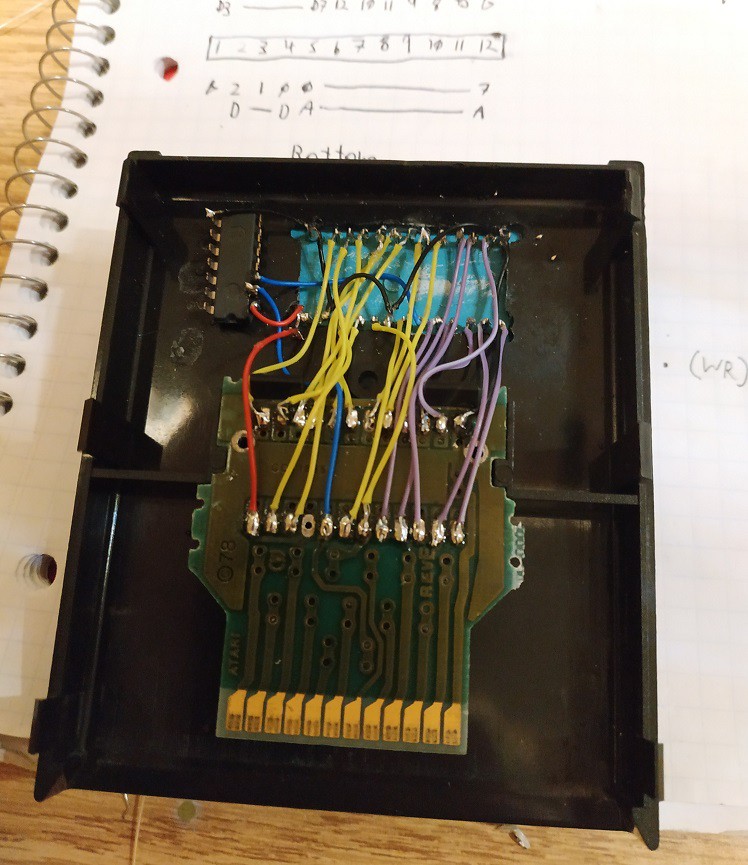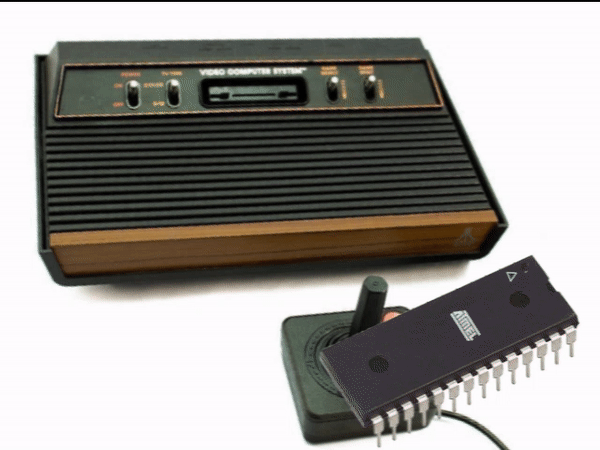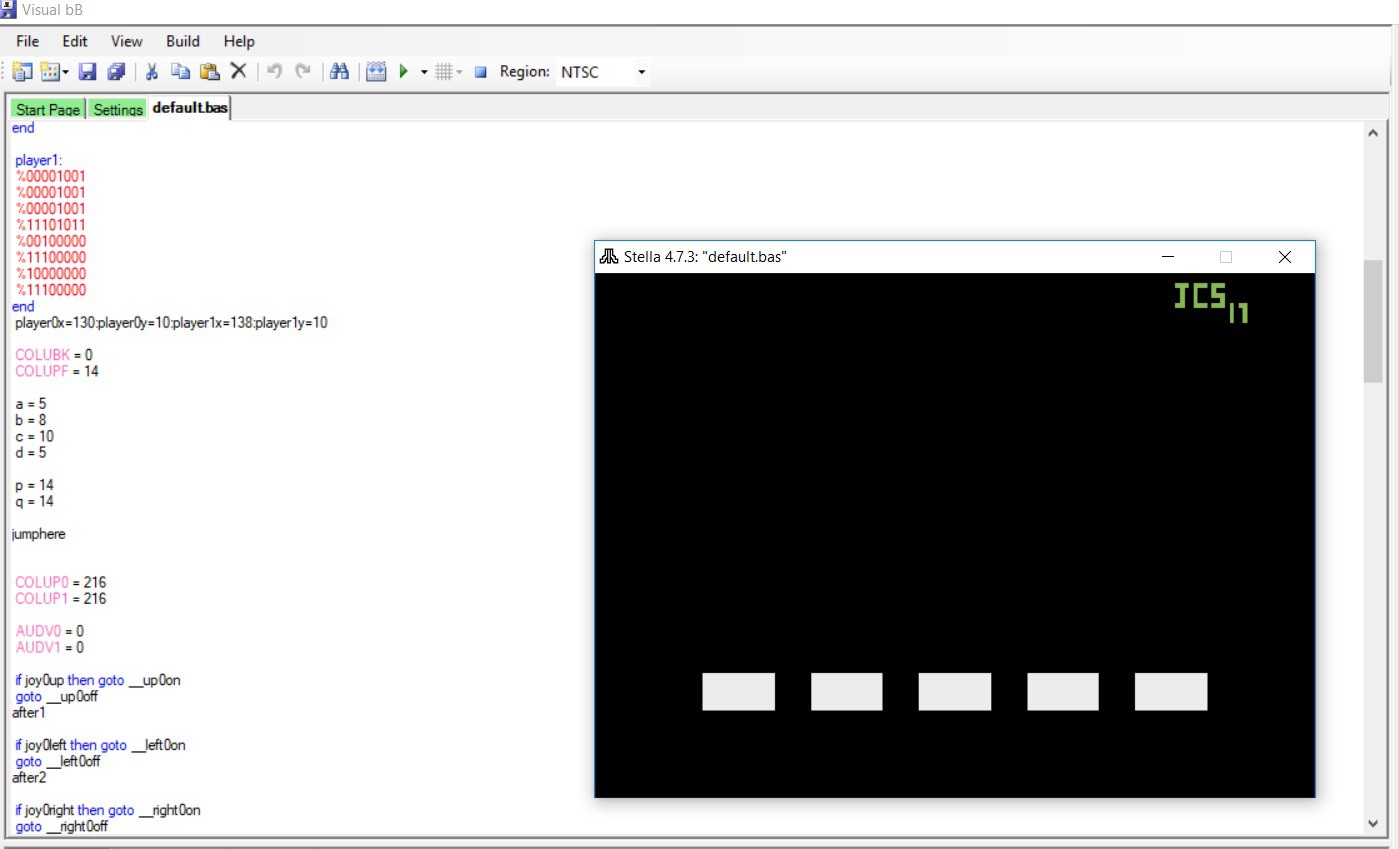-
Log 5: Building A Better Cartridge
09/30/2018 at 21:51 • 0 comments"Goddamn, that last cartridge was terrible! I can do better than that!"
So, I did.
Ahhh, much better This cartridge has new features like:
> Will work
> Not finicky
> It's an actual cartridge
> May summon wizards
The first matter of business was to find a new cartridge pcb. After digging through one of many boxes of junk, I found the pcb & ROM for Asteroids (I turned the cartridge into a guitar pedal a while back). After de-soldering the mask ROM, I placed the board in an old Combat cartridge, removed the labels, and cut out a hole for the zif socket.
![No wonder it doesn't work, it's got a big hole in it! No wonder it doesn't work, it's got a big hole in it!]()
The wiring is the same as the previous cart, except I now have an actual A11 address line!
![b'youtiful b'youtiful]()
-
Log 4: MIDI-fy it!
09/30/2018 at 21:00 • 0 commentsI can now plug a controller into my Atari 2600 (VCS?) and make neat 8-bit drum sounds.
"Hey, that's cool and all, but isn't MIDI a thing?" -some part of my brain
Well I'm glad I asked.
![The (5) and (4) over "current sync" and "current source" are pins on the DIN-5 connector The (5) and (4) over "current sync" and "current source" are pins on the DIN-5 connector]()
Boom! The answer to "Why can't I plug my MIDI device into my Atari?" is here.
A little hardware MIDI interface circuit I whipped up takes the weird electrical stuff coming out of the DIN-5 connector, and presents it in a more traditional TTL fashion to an Arduino Nano. A toggle switch on the RX line allows for the Arduino to be reprogrammed without removing it from the circuit (the Arduino uses the same hardware UART for programming the chip and for serial communication, in this case MIDI). Pins D2-D6 serve the button signals to the Atari VCS (2600?), which are active low.
The Arduino sketch is located here on Github.
The code is recycled from a couple other projects that involve doing things in response to MIDI messages, which is why it looks like trash. Only MIDI channel 10 gets recognized by the Arduino and the following MIDI note numbers trigger the drum sounds.
35 - sound 1
42 - sound 2
45 - sound 3
50 - sound 4
38 - sound 5 (which I didn't program in SYNDRUM but will still trigger the Fire button)
Even if you don't end up using this with SYNDRUM, it will at least make for an interesting Atari controller. Imagine playing River Raid or Pitfall! with this and a set of MIDI pads or a keytar!
![Inside the MIDI interface /w the Arduino Nano removed Inside the MIDI interface /w the Arduino Nano removed]()
![Controller port interface, USB [for programming only], and programming switch. Controller port interface, USB [for programming only], and programming switch.]()
![DIN-5 MIDI port DIN-5 MIDI port]()
-
Log 3: Reading The EEPROM - An Atari's Perspective
09/27/2018 at 21:17 • 0 commentsMy code is now on a chip that was made in 2017! Great, now how do I get it to talk to a machine that was designed in the mid-70's?
![No. Just stop. No. Just stop.]()
After numerous attempts at trying to cram the EEPROM into the cartridge slot, I've gone for the meticulous route of designing a custom circuit and reproducing it using proto-board and cannibalized Atari cartridges.
Not wanting to go through the trouble of having to design and pay for a custom pcb, I used an old Combat cartridge pcb to handle the "plugging in to the Atari part", a zif socket to hold the EEPROM and a bunch of wires from an old LPT printer cable.
Here's what I was thinking electrical wise:
![I marked the key differences between the two chips [left] and used that as the basis of the schematic [right] I marked the key differences between the two chips [left] and used that as the basis of the schematic [right]]()
The cartridge port acts as a pretty straight-forward bus for the Atari's Data lines (pink dots in the schematic) and Address lines (green dots). Pin 6 on the top row acts as the chip select, which had to be inverted since the Atari's original mask roms have the CS line active high rather than low like in the EEPROM. All other address lines on the EEPROM are pulled low.
And when I finally went to assemble everything according to the schematic, I goofed.
The Combat rom was only 2k.
SYNDRUM is 4k.
There was no A11 address line (and subsequently, no A11 pin) on the Combat cartridge. Instead of panicking and instinctively hurling a half-finished circuit board at the nearest brick wall, I instead super-glued a bit of metal where an A11 address line should have been and soldered it to it's respective bit of wire.
![The purple wire that goes through that hole SHOULD connect to that A11 pin. So much for consistency between pics. The purple wire that goes through that hole SHOULD connect to that A11 pin. So much for consistency between pics.]()
The result is something that's definitely not pretty to look at and works only if you have your tongue at the right angle, but it DOES work!
![One step closer to taking over the world. One step closer to taking over the world.]()
It's ALIVE! -
Log 2: EEPROM Programming
09/26/2018 at 22:48 • 0 comments![Hi! Hi!]()
Behold! The AT28C256 EEPROM After batari Basic compiled the the program into a binary file (default.bas.bin), I burned it to an EEPROM [in this case an Atmel AT28C256].
The EPROM programmer I used was one of those little TL866II Plus programmers you find after searching "eprom programmer" on eBay and checking the 'Under $75.00' box.
![]()
Upon receiving the programmer with a highly suspect mini CD, I set up a Windows XP VM and tossed the disk in the trash. Then I needed the software. After some extensive googling, I found it in some sketchy back-alleyway of the internet:
Yeah, run this one in a VM. I used version minipro_setup671 and it seemed to work without much fussing about. Obviously, I'd recommend picking up a name-brand programmer with all kinds of fancy software support that WON'T steal your credit card number in the background. Well, if you have the means...
![Ah, the memories! Ah, the memories!]()
My computer might be at risk. Better delete system32. -
Log 1: batari Basic
09/25/2018 at 16:04 • 0 comments![VisualbB VisualbB]()
SYNDRUM running on Stella /w VisualbB in the background After nearly a year of work (in reality, a few hours of work), here it is! My garbage code that runs on Atari's Video Computer System! OK, all joking aside, this is a much better alternative to writing in 6502 assembly. It just works, and that's all I need it to do.
The batari Basic code & .bin file can be found here.
At the bottom of the screen are 5 blocks. Each block corresponds to a different drum sound and a different button on the controller [UP, LEFT, RIGHT, DOWN, and FIRE].
The blocks act as VU meters. When each sound is triggered, it activates the corresponding meter and changes the color of the screen.
The 5th block doesn't do anything. There was a substantial bit of lag in the emulator with all the graphics and conditional branching in the program, so I chose not to add a 5th voice. I even made a version without any graphics to get rid of this alleged lag, which turns out was a fault in the emulator. Despite the program running lag-free on actual hardware, I chose not to add a 5th voice after the fact because I'm way too lazy for that kind of nonsense and have other projects to work on. Jeez!
Where were we? Ah right, the graphics! This is what the VU meters look like:
![No, they don't reset to white afterwards No, they don't reset to white afterwards]()
VU meters made from batari Basic playfield blocks The meters are made of 'playfield blocks' and not actual sprites. The VU meters all change to the same color depending on the sound that's triggered. They don't keep their individual colors because I'm just not that good. You also may have noticed the 'JCS17' up in the top right. I'm keeping it 17 because '18' is too wide and won't fit in the two playfield sprites that make up 'JCS17'.
So there it is! A mostly functional, bodged-together program written over to course of a year!
Why did I mark this as finished?
SYNDRUM: An Atari 2600 Drum Machine
Yeah, so I wrote a little program and built a hardware interface that turned my Atari VCS into a MIDI-capable drum machine
 John Sutley
John Sutley




![Controller port interface, USB [for programming only], and programming switch. Controller port interface, USB [for programming only], and programming switch.](https://cdn.hackaday.io/images/4608841538342576576.jpg)


![I marked the key differences between the two chips [left] and used that as the basis of the schematic [right] I marked the key differences between the two chips [left] and used that as the basis of the schematic [right]](https://cdn.hackaday.io/images/3511861538254627776.png)






